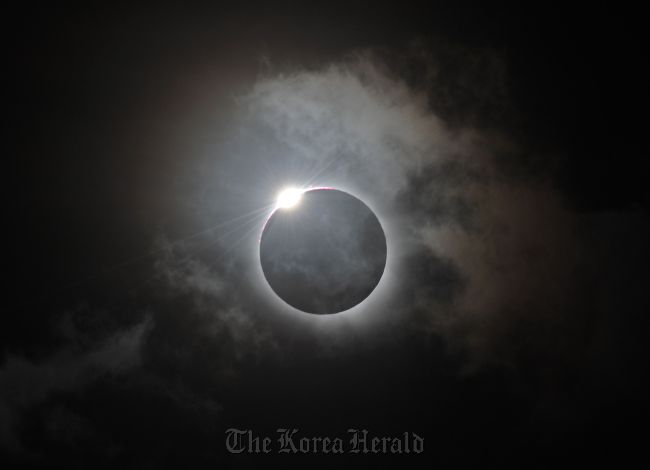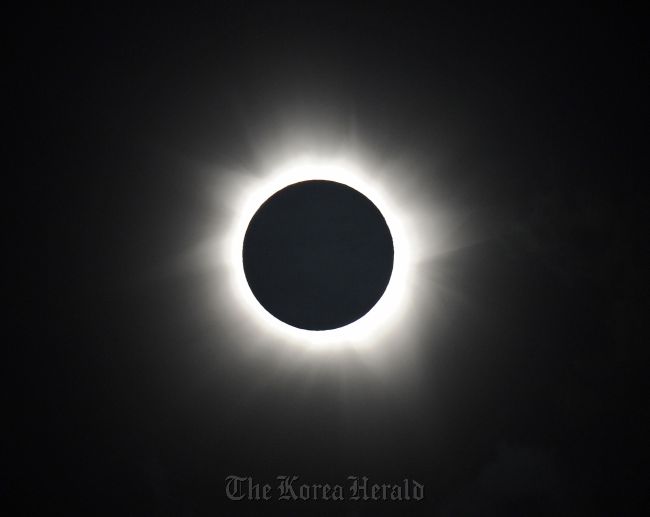 |
The Diamond Ring effect is shown following totality of the solar eclipse at Palm Cove in Australia's Tropical North Queensland on November 14, 2012. (AFP) |
 |
Totality is shown during the solar eclipse at Palm Cove in Australia's Tropical North Queensland on November 14, 2012. (AFP) |
Sky-gazers in northern Australia donned protective glasses as the clouds parted Wednesday to allow them to witness one of nature‘s greatest phenomena -- a total eclipse of the sun.
All eyes and cameras turned to the heavens over tropical north Queensland as the moon began moving between the Earth and the sun, like a small bite which gradually increases in size.
Cloud cover threatened to spoil the party and huge cheers erupted when they parted to give tens of thousands of eclipse hunters a perfect view of totality -- when the moon completely covers the sun and a faint halo or corona appears.
“Wow, insects and birds gone quiet,” one tourist, Geoff Scott, tweeted.
Another, Stuart Clark, said: “This it it. Totality now. Utterly beautiful.”
The path of the eclipse got under way shortly after daybreak when the moon’s shadow, or umbra, fell in the Garig Gunak Barlu National Park in the Northern Territory, about 250 kilometers (155 miles) east of Darwin.
The umbra then moved eastward before alighting in north Queensland -- one of the few places it could be viewed by humans and where tourists and scientists flocked to witness the region‘s first total solar eclipse in 1,300 years.
Totality lasted just over two minutes from 6:38 a.m. (2038 GMT Tuesday).
When it happened the early chatter of birds and animals was replaced by an eerie silence as the moon overtook the sun, casting a shadow that plunged the land into darkness, with temperatures dropping.
“Day into night, unbelievable, goosebumps, speechless, amazing,” said Palm Cove eclipse watcher Simon Crerar.
Fred Espenak, an American astrophysicist and world authority on eclipses, told the Australian Broadcasting Corporation that while eclipses can seem somehow magical, in fact they can be predicted accurately.
“Certainly within 100 to 200 years we can predict when an eclipse will occur to within a second,” he said.
“But the pattern of occurrence is a complicated one. They don’t repeat on a time schedule like the seasons of the year.”
He explained that when a total eclipse occurred “the darkest part of the moon‘s shadow sweeps across the earth’s surface”.
“Total solar eclipses occur once every one to two years but are only visible from less than half a percent of the earth‘s surface,” he said.
The rare spectacle, which was viewed live by millions around the world, drew thousands of eclipse tourists to Queensland with the state government estimating that 50,000-60,000 people made the trip.
They include three charter flights with 1,200 scientists from Japan while six cruise ships were moored off the coast and hot air balloons dotted the skies.
Accommodation was solidly booked -- from five-star hotels to camping grounds.
Scientists will study the effects of the eclipse on the marine life of the Great Barrier Reef and Queensland’s rainforest birds and animals while psychologists will monitor the impact on humans.
Total eclipses can be seen from a given point on Earth‘s surface only once every 410 years in the northern hemisphere, but only once every 540 years in the southern hemisphere.
The last total eclipse was on July 11, 2010, again over the South Pacific.
The next will take place on March 20, 2015, occurring over Iceland, the Faroe Islands and Norway’s far northern Svalbard archipelago, according to Espenak. (AFP)
<관련 한글 기사>
황홀한 개기식, 동물들도 조용해
오스트레일리아 북부에서 개기식이 관찰되었다.
북부 퀸스랜드(Queensland) 부근에서 보인 이번 현상은 달이 지구에서 태양까지 움직이면서 발생하였다. 당시 구름이 껴 관찰이 어려울 것이라 예상되었지만 보호 글래스를 통해 관찰에 어려움이 없었던 것으로 전해졌다.
달이 태양을 완전이 덮을 경우 희미한 후광이나 코로나가 나타난다. “와, 모든 곤충과 새들도 조용해졌어요.”라고 지오프 스콧(Geoff Scott)이라는 관광객이 트위터에 남겼다. 또다른 이인 스튜어트 클락(Stuart Clark)은 “이거에요. 바로 지금이에요. 말할 수 없이 아름다워요.”라고 말했다. 개기식은 새벽 직후 다윈으로부터 250km 떨어진 곳에서부터 달 그림자가 지면서 시작되었다.
달 그림자는 점점 동쪽으로 움직여서 퀸스랜드에서 빛을 발했다. 이 곳은 사람들이 쉽게 개기식을 관찰할 수 있는 유일한 곳이었다. 이 곳에는 이 지역에서 1,300년 동안 한 번도 없었던 첫 개기식을 보기 위해 관광객과 과학자들을 포함해서 수많은 사람들이 몰렸다.
달에 의해 태양이 완전히 덮여있던 시간은 2분이었다. 이는 GMT 기준 오전 6시 38분이었다. 이 때는 새소리 및 동물들이 내는 소리 등이 모두 사라지고 사방이 조용했던 것으로 전해졌다. 매우 어두웠으며 기온도 약간 떨어졌다.
“낮에서 밤이 되었네요. 믿기지 않아요. 소름 돋아요. 말을 할 수도 없을 지경이고요. 놀랍습니다.”라고 개기식을 관찰하던 사이먼 크레러(Simon Crerar)가 말했다.
미국 천문물리학자인 프레드 에스페낙(Fred Espenak)은 호주방송에 개기식이 아주 마법 같은 광경이었음에도 사실 이는 정확히 예측가능한 것이었다고 말했다. “그래도 이건 완전한 개기일식이었고, 절대 자주 있는 일이 아니죠.”라고 덧붙였다. “완전한 개기일식은 1~2년에 한 번씩 있지만 지구에서 이것을 관찰하는 것은 모든 경우에 가능한 것은 아니고 반 정도만 됩니다.”라고 에스페낙은 전했다.
개기식을 보기 위해 5-6만 명의 사람들이 퀸스랜드로 모여들었다고 주 정부는 밝혔다. 일본의 1,200명의 과학자를 실은 전세기 세 대가 왔고, 여섯 대의 크루즈와 에어벌룬까지 동원된 것으로 드러났다. 숙박시설 또한 만원이었다. 과학자들은 그레이트배리어리프(Great Barrier Reef)와 퀸스랜드 열대림 지역 생태계에 있어서 개기식과 해상생물과의 관계를 연구할 예정이며 심리학자들은 개기식이 사람들에게 미치는 영향을 살펴볼 것이라고 전했다.
완전한 개기식은 지구의 특정 장소에서만 관찰이 가능하다. 개기식은 410년에 한 번씩 북반구에서, 540년에 한 번씩 남반구에서 발생한다.
지난 개기식은 2010년 7월 11일 남태평양 해상에서 일어났다. 다음 개기식은 아이슬랜드와 노르웨이의 북부에서 2015년 3월 20일 발생할 것으로 예상된다고 에스페낙이 전했다.




![[KH Explains] Why Yoon golfing is so controversial](http://res.heraldm.com/phpwas/restmb_idxmake.php?idx=644&simg=/content/image/2024/11/13/20241113050608_0.jpg)




